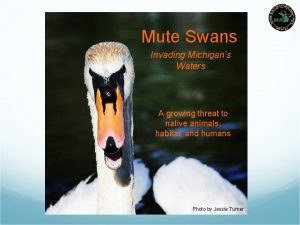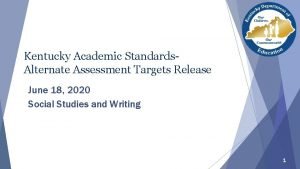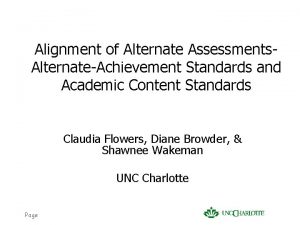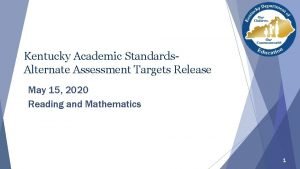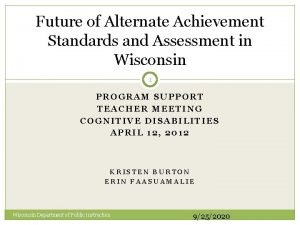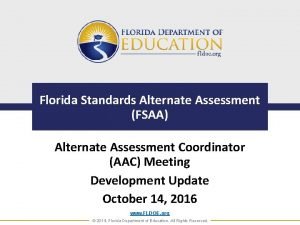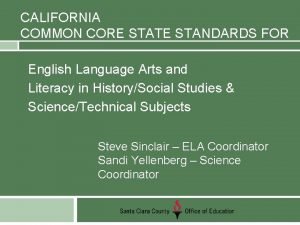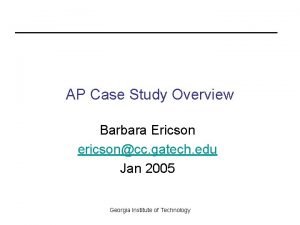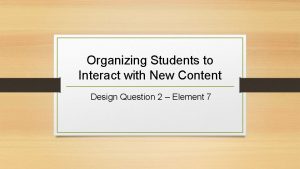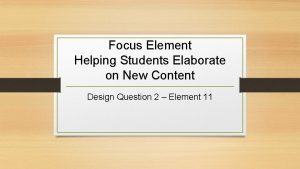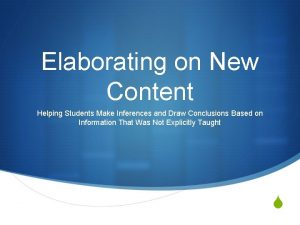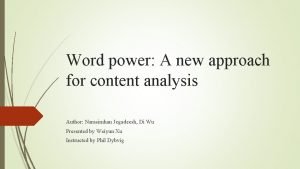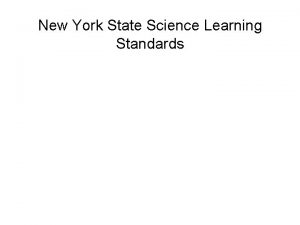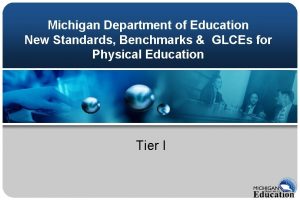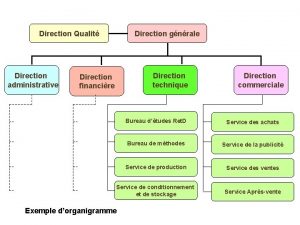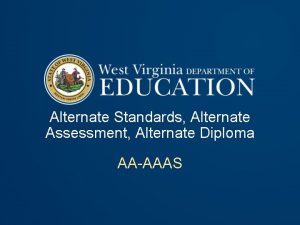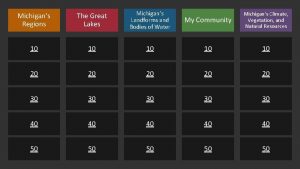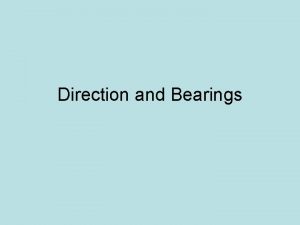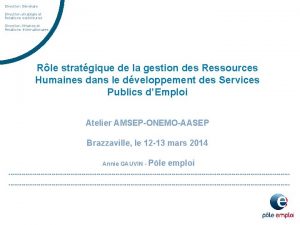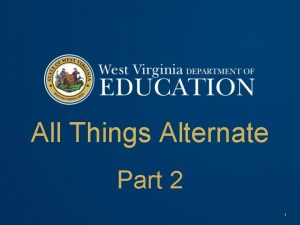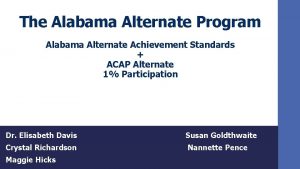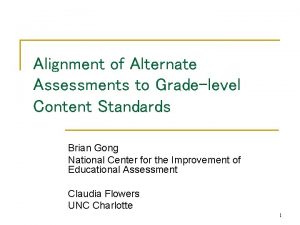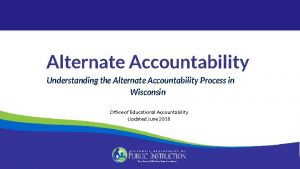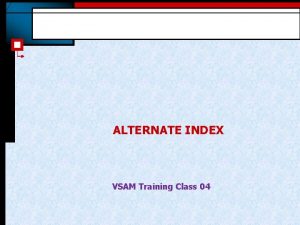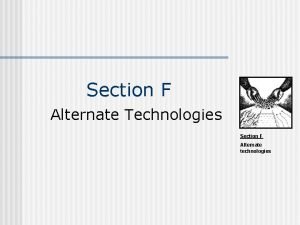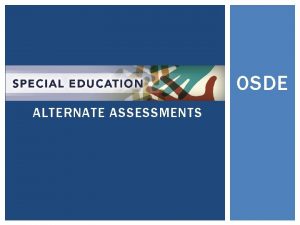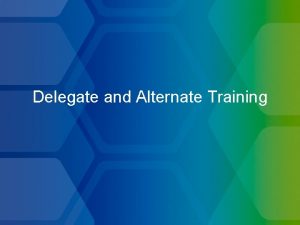Michigans Alternate Standards A New Direction Alternate Content
































- Slides: 32

Michigan’s Alternate Standards: A New Direction

Alternate Content Standards: Then and Now � 2014 -2015 School Year- Extended Content Expectations English Language Arts Mathematics Science Social Students � 2015 -2016 School Year– Michigan Essential Elements (EEs)* English Language Arts Mathematics � 2015 -2016 School Year– Extended Content Expectations Science Social Studies * Represents a change

Why the Shift in Alternate Content Standards? �EGLCES/EHSCEs in ELA and Mathematics no longer aligned with general content standards �Joined the Dynamic Learning Maps Consortium Development of Essential Elements Development of Alternate Assessment �Determined that the DLM alternate assessment would not meet Michigan’s needs �Michigan will use the Essential Elements EEs were developed by members of the Consortium including Michigan special and general education teachers Decision made based on feedback from educators around the state and advisory committees

Proposed Michigan Essential Elements with Range of Complexity �Michigan educators designated which Essential Elements would be measured at the state level keeping the strands measured by the general assessment in mind �Assessed in Spring 2016 �Assessment will contain some items that meet the extended content expectations and essential elements �Educator Panels designated which EEs would be measured on the assessment and the Ranges of Complexity

Revisions to drafts completed �Public comment and Specific Feedback surveys (to those in the field) were open in August through early October of 2015 �Comments received for both ELA and Mathematics at every grade level and content area on most of the Essential Elements and Range of Complexity language (conflicting opinions often) �Feedback received by item writers and item reviewers during new item development and item review this summer and early fall. �Adjustments made to the Range of Complexity (High, Medium, Low) �Adjustments made to corresponding items �Updated draft documents �Test maps currently being built

Ranges of Complexity ENGLISH/LANGUAGE ARTS EXAMPLE Target Essential Element EE. L. 4. 2 a Demonstrate understanding of conventions of standard English. Michigan Range of Complexity High Range Medium Range EE. L. H. 4. 2. a The student can EE. L. M. 4. 2. a The identify which word/words should student can identify be capitalized in a sentence (first capital letters and words and proper nouns) and/or basic punctuation choose the correct ending (periods and punctuation (period, question marks). or exclamation point). Low Range EE. L. L. 4. 2. a The student can differentiate if a sentence is a statement or a question.

Ranges of Complexity MATHEMATICS EXAMPLE Target Essential Element High Range EE. 5. NBT. 3 EE. 5. NBT. H. 3 The student Compare whole numbers can compare whole up to 100 using symbols (<, numbers up to 100 using >, =) symbols (<, >, =) Michigan Range of Complexity Medium Range EE. 5. NBT. M. 3 The student can identify which numerals (0 -10) are “greater than, ” “less than, ” “more than” or “fewer than” a targeted number Low Range EE. 5. NBT. L. 3 The student can identify which numeral, paired with a visual representation of its quantity, is greater than another numeral, also paired with a visual representation of its quantity (numerals 0 -10)

MATHEMATICS EXAMPLE Representation of Changes

Essential Elements WAYNE RESA WORK

A Snapshot: 4200 students with cognitive impairment 3500 students with autism spectrum disorder 10

“I Can” Statements for Today v. I can demonstrate the alignment of “I Can” statements to the EE Range of Complexity. v. I can share how Wayne RESA teachers use “I Can” statements in planning, teaching, and reporting on student learning.

DLM 1 st Release of the Essential Elements

DLM 2 nd Release of the Essential Elements

Unwrapping Standards 1. Select a Standard. 2. Underline the nouns (concepts) and circling the skills (verbs). 3. Record the concepts and skills in a chart. 4. Place into “I Can”, student friendly language.

Why Use “I Can” Statements 1. The complex standard is stated in simple terms. 2. “I Can” statements can be sequenced as part of instructional planning. 3. “I Can” statements involve the students in knowing what it is they are to do and understand. 4. “I Can” statements lend themselves to learning targets and paced assessments. 5. “I Can” statements are easily communicated to parents and paras.

Wayne RESA Teachers “I Can” Statements

Michigan Range of Complexity

RL 3. 1 Ask and answer questions to demonstrate understanding of a text, referring explicitly to the text as the basis for the answer. EE 3. 1 Answer who and what questions to demonstrate understanding of details in a text. MI: Range of Complexity (FI) The student can use details to answer questions about the plot, setting, and characters in a narrative text. MI: Range of Complexity (SI) The student can answer questions about basic elements in a narrative text (e. g. , character’s names, settings, and specific events). MI: Range of Complexity (PI) The student can answer simple who, what, or where questions in a narrative text. MI: Also Assessed with standard RL 3. 1 EE. RL. 3. 2: Associate details with events in stories from diverse cultures. EE. RL. 3. 3: Identify the feelings of characters in a story.

Wayne RESA I Can Statements RL 3. 1 RL 3. 2 RL 3. 3 4. I can answer who and what questions from a story. 4. I can retell fables, folktales, and myths using details. 4. I can recognize and describe the feelings of characters in a story. 3. I can answer who and what questions after listening to a story. 3. I can retell fables, folktales, and myths using pictures. 3. I can recognize the feelings of characters in a story. 2. I can choose the answer to who and what questions in a story. 2. I can choose fables, folktales, 2. I can match symbols, and myths that retell a story. pictures, or words to show I know the feelings of characters in a story. 1. I can look at fables, folktales, and myths that retell a story. 1. I can look at a picture that shows the feeling of characters in a story. 1. I can look at who and what pictures from a story that is being read.

“I Can” in Classrooms (Livonia)

I Can in a Lesson http: //mistreamnet. org/videos/2955/bradd-equation-board

“I Can” Tracking Learning Sheets EE 3. 1 Answer who and what questions to demonstrate understanding of details in a text. 4. I can answer who and what questions from a story. 3. I can answer who and what questions after listening to a story. 2. I can choose the answer to who and what questions in a story. Student Week 1 Week 2 Week 3 Week 4 Total Comments

Lessons Learned 1. The Range of Complexity is setting a high expectation for each of the MI-Access assessments. 2. Having the “I Can” statements is helping teachers to organize their planning and communication about what they are teaching. 3. Students are more engaged in their learning. 4. The teachers were finding a comfort level of working toward the Range of Complexity expectation accepting where there students are in their learning progress toward that expectation.

I Can http: //mistreamnet. org/videos/3293/i-can

The Ottawa Area Center The Journey: Unpacking Standards and Linking to the Essential Elements

Where we were… EGLCEs and School Wide Themes Around 2009 OAC started to make a change. . . Staff were very apprehensive Very limited accountability for teaching standards Lesson plans changed 3 year cycle Help ease into the change Slower pace for our students

Then came the changes… Common Core State Standards Dynamic Learning Maps NCSC Based in Kansas Kentucky and North Carolina Essential Elements Graduated Understandings Linkage Levels Core Content Connectors

How did we unpack the Essential Elements the first time? At first, we were nervous. EE’s were only academic, not functional Initial Precursor made it possible! Took all EE’s and placed them in like piles According to Initial Precursor levels Found a pattern Initial Precursor skills appeared in multiple grade levels

Core Skills Based on the Initial Precursors found in the Essential Elements, OAC created Instructional Families and Core Skills Levels System

How are we transitioning to the Michigan Essential Elements?

Partnership Working with local CI teachers in the general education setting to provide content, assessments, and themes that everyone can use. Provided PD for 50 CI teachers in the local setting Creating a team that will be able to take the curriculum frameworks to the next level Daily Living Core Skills 5 level system Help us not forget about functional skills

OAC Curriculum Frameworks Shared Folder https: //goo. gl/TQAU 6 j Taylor Otten totten@oaisd. org
 Whats michigans state bird
Whats michigans state bird Ky alternate assessment standards
Ky alternate assessment standards Alternate standards alignment
Alternate standards alignment Kentucky alternate assessment
Kentucky alternate assessment Alabama alternate achievement standards 2020
Alabama alternate achievement standards 2020 Fsaa teacher training modules
Fsaa teacher training modules What is esp
What is esp Static content vs dynamic content
Static content vs dynamic content English content standards
English content standards California state standards english
California state standards english Colorado model content standards
Colorado model content standards New direction water pump
New direction water pump A new direction
A new direction Factors necessary for appropriate service standards
Factors necessary for appropriate service standards Organizing students to interact with content
Organizing students to interact with content Using questions to help students elaborate on content
Using questions to help students elaborate on content Helping students elaborate on new content
Helping students elaborate on new content Word power: a new approach for content analysis
Word power: a new approach for content analysis New york state learning standards science
New york state learning standards science New jersey social emotional learning standards
New jersey social emotional learning standards Measurement standards laboratory
Measurement standards laboratory New standards michigan
New standards michigan Nmc scphn new standards
Nmc scphn new standards Examples of inverted commas
Examples of inverted commas New york, new jersey, pennsylvania, and delaware
New york, new jersey, pennsylvania, and delaware Fresh oil new wine
Fresh oil new wine Marquee theatre new hartford ny
Marquee theatre new hartford ny Articles of confederation characteristics
Articles of confederation characteristics New-old approach to creating new ventures
New-old approach to creating new ventures The actual and potential rival offerings and substitutes
The actual and potential rival offerings and substitutes Njbta
Njbta New classical and new keynesian macroeconomics
New classical and new keynesian macroeconomics Chapter 16 toward a new heaven and a new earth
Chapter 16 toward a new heaven and a new earth
